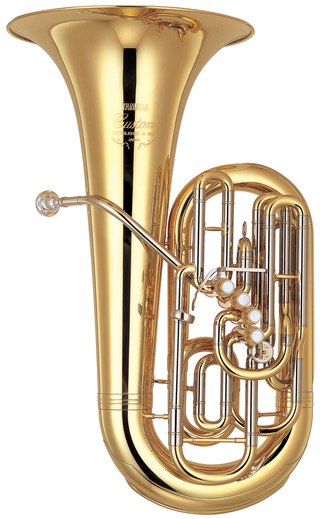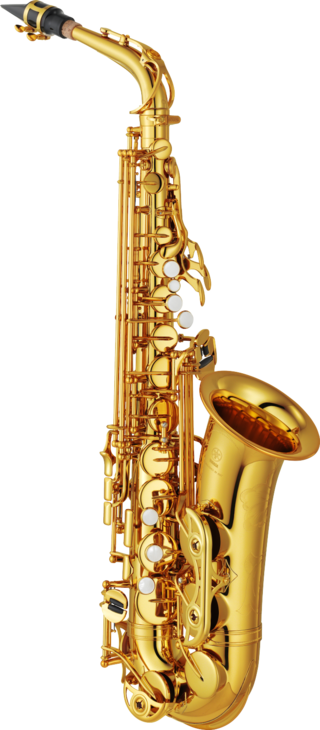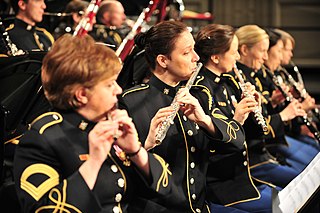Related Research Articles

Antoine-Joseph "Adolphe" Sax was a Belgian inventor and musician who invented the saxophone in the early 1840s, patenting it in 1846. He also invented the saxotromba, saxhorn and saxtuba. He played the flute and clarinet.

A musical ensemble, also known as a music group or musical group, is a group of people who perform instrumental and/or vocal music, with the ensemble typically known by a distinct name. Some music ensembles consist solely of instrumentalists, such as the jazz quartet or the orchestra. Other music ensembles consist solely of singers, such as choirs and doo wop groups. In both popular music and classical music, there are ensembles in which both instrumentalists and singers perform, such as the rock band or the Baroque chamber group for basso continuo and one or more singers. In classical music, trios or quartets either blend the sounds of musical instrument families or group together instruments from the same instrument family, such as string ensembles or wind ensembles. Some ensembles blend the sounds of a variety of instrument families, such as the orchestra, which uses a string section, brass instruments, woodwinds and percussion instruments, or the concert band, which uses brass, woodwinds and percussion.

The saxophone is a type of single-reed woodwind instrument with a conical body, usually made of brass. As with all single-reed instruments, sound is produced when a reed on a mouthpiece vibrates to produce a sound wave inside the instrument's body. The pitch is controlled by opening and closing holes in the body to change the effective length of the tube. The holes are closed by leather pads attached to keys operated by the player. Saxophones are made in various sizes and are almost always treated as transposing instruments. Saxophone players are called saxophonists.

The tuba is the lowest-pitched musical instrument in the brass family. As with all brass instruments, the sound is produced by lip vibration – a buzz – into a mouthpiece. It first appeared in the mid-19th century, making it one of the newer instruments in the modern orchestra and concert band. The tuba largely replaced the ophicleide. Tuba is Latin for "trumpet".

The sarrusophones are a family of metal double reed conical bore woodwind instruments patented and first manufactured by Pierre-Louis Gautrot in 1856. Gautrot named the sarrusophone after French bandmaster Pierre-Auguste Sarrus (1813–1876), whom he credited with the concept of the instrument, though it is not clear whether Sarrus benefited financially. The instruments were intended for military bands, to serve as replacements for oboes and bassoons which at the time lacked the carrying power required for outdoor marching music. Although originally designed as double-reed instruments, single-reed mouthpieces were later developed that could be used for the larger bass and contrabass sarrusophones.
Marcel Mule was a French classical saxophonist. He was known worldwide as one of the great classical saxophonists, and many pieces were written for him, premiered by him, and arranged by him. Many of these pieces have become staples in the classical saxophone repertoire. He is considered to be the founder of the French Saxophone School and the most representative saxophone soloist of his time, being a fundamental figure in the development of the instrument.

Gerald Joseph Mulligan, also known as Jeru, was an American jazz saxophonist, clarinetist, composer and arranger. Though primarily known as one of the leading jazz baritone saxophonists—playing the instrument with a light and airy tone in the era of cool jazz—Mulligan was also a significant arranger, working with Claude Thornhill, Miles Davis, Stan Kenton, and others. His pianoless quartet of the early 1950s with trumpeter Chet Baker is still regarded as one of the best cool jazz groups. Mulligan was also a skilled pianist and played several other reed instruments. Several of his compositions, such as "Walkin' Shoes" and "Five Brothers", have become standards.

The bass clarinet is a musical instrument of the clarinet family. Like the more common soprano B♭ clarinet, it is usually pitched in B♭, but it plays notes an octave below the soprano B♭ clarinet. Bass clarinets in other keys, notably C and A, also exist, but are very rare. Bass clarinets regularly perform in orchestras, wind ensembles and concert bands, and occasionally in marching bands, and play an occasional solo role in contemporary music and jazz in particular.
Contrabass refers to several musical instruments of very low pitch—generally one octave below bass register instruments. While the term most commonly refers to the double bass, many other instruments in the contrabass register exist.

The alto saxophone is a member of the saxophone family of woodwind instruments. Saxophones were invented by Belgian instrument designer Adolphe Sax in the 1840s and patented in 1846. The alto saxophone is pitched in E♭, smaller than the B♭ tenor but larger than the B♭ soprano. It is the most common saxophone and is used in popular music, concert bands, chamber music, solo repertoire, military bands, marching bands, pep bands, and jazz.

The tenor saxophone is a medium-sized member of the saxophone family, a group of instruments invented by Adolphe Sax in the 1840s. The tenor and the alto are the two most commonly used saxophones. The tenor is pitched in the key of B♭ (while the alto is pitched in the key of E♭), and written as a transposing instrument in the treble clef, sounding an octave and a major second lower than the written pitch. Modern tenor saxophones which have a high F♯ key have a range from A♭2 to E5 (concert) and are therefore pitched one octave below the soprano saxophone. People who play the tenor saxophone are known as "tenor saxophonists", "tenor sax players", or "saxophonists".

The baritone saxophone is a member of the saxophone family of instruments, larger than the tenor saxophone, but smaller than the bass. It is the lowest-pitched saxophone in common use - the bass, contrabass and subcontrabass saxophones are relatively uncommon. Like all saxophones, it is a single-reed instrument. It is commonly used in concert bands, chamber music, military bands, big bands, and jazz combos. It can also be found in other ensembles such as rock bands and marching bands. Modern baritone saxophones are pitched in E♭.
The soprano saxophone is a higher-register variety of the saxophone, a woodwind instrument invented in the 1840s. The soprano is the third-smallest member of the saxophone family, which consists of the soprillo, sopranino, soprano, alto, tenor, baritone, bass, contrabass saxophone and tubax. Soprano saxophones are the smallest and thus highest-pitched saxophone in common use.

The tubax is a modified contrabass saxophone developed in 1999 by the German instrument maker Benedikt Eppelsheim. Although it has the same fingering as the saxophone, it has a narrower bore, smaller mouthpiece, and more compactly folded tubing. The tubax exists in E♭ contrabass and B♭ or C subcontrabass sizes. Its name is a portmanteau of the words "tuba" and "sax".

The contrabass saxophone is the second-lowest-pitched extant member of the saxophone family proper. It is extremely large and heavy, is pitched in the key of E♭, one octave below the baritone saxophone.

The bass saxophone is one of the lowest-pitched members of the saxophone family—larger and lower than the more common baritone saxophone. It was likely the first type of saxophone built by Adolphe Sax, as first observed by Berlioz in 1842. It is a transposing instrument pitched in B♭, an octave below the tenor saxophone and a perfect fourth below the baritone saxophone. A bass saxophone in C, intended for orchestral use, was included in Adolphe Sax's patent, but few known examples were built. The bass saxophone is not a commonly used instrument, but it is heard on some 1920s jazz recordings, in free jazz, in saxophone choirs and sextets, and occasionally in concert bands and rock music.

The ophicleide is a family of conical-bore keyed brass instruments invented in early 19th century France to extend the keyed bugle into the alto, bass and contrabass ranges. Of these, the bass ophicleide in C or B♭ took root over the course of the 19th century as the bass of orchestral brass sections throughout Western Europe, replacing the serpent and its later derivatives, the bass horn and basson russe. Its popularity proved short-lived, however; by the end of the 19th century the ophicleide had been largely superseded by early forms of the modern tuba.

The sopranino saxophone is the second-smallest member of the saxophone family. It is tuned in the key of E♭, and sounds an octave higher than the alto saxophone. An F sopranino were described in Adolphe Sax's patent, but no known examples have ever been built.

Sigurd Manfred Raschèr was an American saxophonist born in Germany. He became an important figure in the development of the 20th century repertoire for the classical saxophone.

The woodwind section, which consists of woodwind instruments, is one of the main sections of an orchestra or concert band. Woodwind sections contain instruments given Hornbostel-Sachs classifications of 421 and 422, but exclude 423
References
- ↑ "Nuclear Whales Saxophone Orchestra", Ron Wynn, Allmusic
- 1 2 "Calling All Saxophonists... Gunther Schuller to Conduct 1,000-Saxophone Concert Atop the Great Wall", PR Newswire, 24 October 2002
- ↑ "The Nuclear Whales – The Early Years"
- 1 2 "Sax 'family' of six set to play", China Daily, 27 September 2003